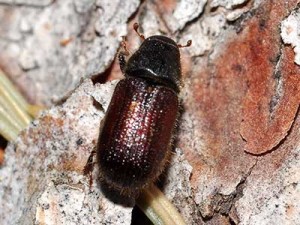
From afar, the tree awed me with its size and beauty. Growing along North Boulder Creek, its branches drooped with green-blue needles and cones. Its top soared every higher towards the blue sky.During this May afternoon, the tree seemed perfectly healthy. Upon closer inspection, though, I saw sap oozing out of the deeply furrowed bark.
But that sap made me think of blood seeping from my skin. The small punctures in the bark reminding me of wounds. It told the story of something creeping around inside of the tree. Making tunnels, laying eggs. Planting the seeds of death for the tree.
Five years ago, I thought we had finally come out the other side of this insidious epidemic. The beetle epidemic. The one thought that killed hundreds of thousands of Lodgepole pine trees throughout Colorado and the western United States.
Driving west on Interstate 70, it’s hard to remember what the mountains looked like before the pine beetle epidemic. That they used be hills of green, instead of grove upon grove of gray, ghost trees. Those tiny beetles burrowed into the trees, already weakened by drought. Their presence basically strangled the trees, depriving them of water and nutrients and killed millions of trees.
I thought we finally had entered a respite from this tiny, murdering creature.
But listening to an interview with an ecologist on Public Radio, I realized it’s not over. One beetle leaves, and another comes along. This time the Spruce beetle. The Colorado State Forest Service estimate the Spruce beetle has infested 40% of the state’s spruce-fir forests.
Apparently, climate change is in part to blame for the surge in spruce beetle populations. They carry glycol, a type of anti-freeze in their bodies. This allows them to withstand sub-freezing temperatures down to 40 degrees below zero without dying. Fifty years ago, the Rocky Mountains had cold snaps that would kill off the beetles, but no longer.
Also, later freezes in the fall have allowed the beetles to lay more eggs, leading to an uptick in population. With winters continuing to get warmer, the beetles are here to stay.
Despite all the doom and gloom, there is some good news this coming summer. With record snowfall, Colorado’s forests will have ample moisture to draw upon. More water means more resin for the spruce trees. Resin allows the tree to defend itself in two ways. By expelling the beetles through its “sap”, and through the scent it gives off, repelling the beetles.
We can only hope for more snow and more rain to stave off these tiny, but mighty creatures.

